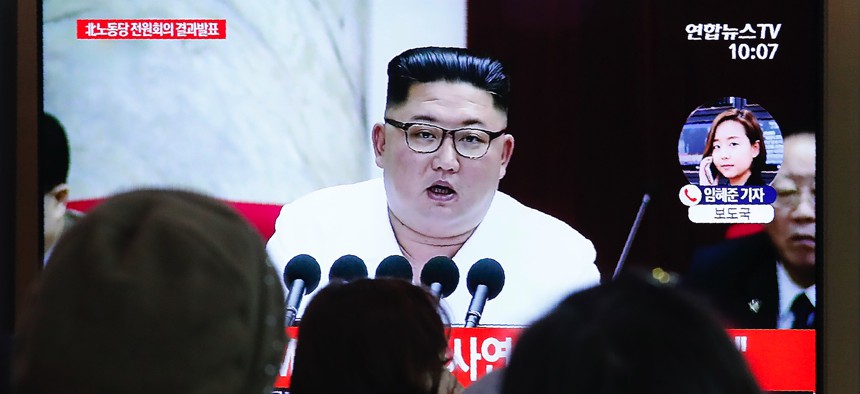
People watch a TV screen showing a file image of North Korean leader Kim Jong Un during a news program at the Seoul Railway Station in Seoul, South Korea, Wednesday, Jan. 1, 2020. AP / Ahn Young-joon
What If Kim Jong Un Dies?
Improvements in U.S.-North Korean relations would still largely be up to Washington.
Is North Korean leader Kim Jong-un dangerously close to death, recuperating from a cardiovascular procedure, or running the country in a business-as-usual fashion? A single-sourced report recently sparked an international rumor mill about the health of the 36-year-old Kim. While the South Korean government was quick to denounce the report, the U.S. intelligence community is closely monitoring developments related to Kim’s health.
Due to tightly controlled information, speculating about the inner workings of the Kim dynasty is a favorite pastime for North Korea watchers. But it also distracts from the more critical question: will a change of authority at the top suddenly produce a North Korea more amenable to Washington’s unflinching denuclearization demand?
The realistic answer is no, it won't. And it’s past time for Washington to adjust policy to deal with that reality.
While Kim Jong-un undoubtedly calls the shots in his country—the North Korean government, after all, has been a family dynasty ever since North Korea was created in the aftermath of World War II—personalities are not the only drivers of state behavior. Balance-of-power dynamics, regional politics, diplomatic relationships, and core security interests are more important than individuals.
Related: The Coronavirus Gives the US a Chance to Restart Talks with North Korea
Related: America’s Allies Are Becoming a Nuclear-Proliferation Threat
Assume for a moment that the world wakes up to news of Kim Jong-un's death. How would the Workers Party and Kim’s inner circle react? Outside of assembling a smooth transition to ensure continuity of government and jousting behind the scenes between competing power centers, North Korea’s foreign policy, its perception of its security environment, and the value it attaches to its nuclear deterrent are unlikely to change.
North Korea post-Kim would be in the very same position as it was when Kim Jong-un was the center of authority. The country will still be the metaphorical “shrimp among whales,” an economic basket case hemmed in by far wealthier neighbors to the east and west and tightly limited by international sanctions. The North Korean economy would still be struggling for air, looking paltry in comparison to South Korea, whose per capita GDP ($42,246) is 42 times larger than the North Koreans’ $1,298 per person. The North Korean leadership will remain almost completely dependent on China for political cover, trade, and supply chains.
The threat environment for Pyongyang will hardly be any different either. The United States and the U.N. Security Council will continue to push and prod for North Korea’s complete, verifiable, and irreversible denuclearization regardless of whether Kim Jong-un is dead, alive, or incapacitated. In fact, with Kim out of the picture, Washington may be even more insistent and aggressive on this demand. Kim or no Kim, the U.S. and U.N. sanctions that have capped North Korea’s exports and negatively impacted practically every individual funding stream for the regime will remain intact—a development a future North Korean government will likely interpret as a continuation of a deliberate U.S. strategy to foment regime change.
To summarize, the strategic environment that has constrained North Korea’s freedom of movement and blocked the normalization of U.S.-North Korea relations for the past seven decades won’t disappear with Kim Jong-un. North Korea will have as much incentive to surrender its nuclear deterrent in a post-Kim world as it does today: none whatsoever.
Kim Jong-un is not the only North Korean military or political official who believes dismantling or surrendering Pyongyang’s nuclear weapons arsenal would be a foolish, if not suicidal, mistake for its security and regime stability. Whether Washington likes it or not, the Hermit Kingdom will remain a nuclear state.
The United States has two choices to manage the reality it now faces. It can continue on the current course and pile more pressure on Pyongyang, returning tensions to the “fire and fury” days of 2017 for no gain and risking a violent regional conflict.
Or it can do the prudent thing by going back to the drawing board, reassessing the basic assumptions that have underwritten two decades of failed U.S. policy on North Korea, and tailor its strategy to more realistic and achievable objectives. Those objectives include what many in the Beltway have totally opposed exploring: dropping the demand for up-front denuclearization; improving the U.S.-North Korea bilateral relationship; negotiating an arms reduction mechanism both sides could live with; and support rather than hinder the current South Korean government’s noble quest for inter-Korean reconciliation. Given its overwhelming conventional and nuclear superiority, Washington can deter Pyongyang from attacking the U.S. indefinitely.
The conventional Washington paradigm on North Korea has been a systemic failure across the board. This will remain the case regardless of whether Kim Jong-un, his sister, or a North Korean field marshal is the ultimate authority. The sooner persistent but stale assumptions are discarded, the sooner the U.S. can settle on a policy that will safeguard U.S. interests and lessen the probability of conflict.
NEXT STORY: How China Sees the World



